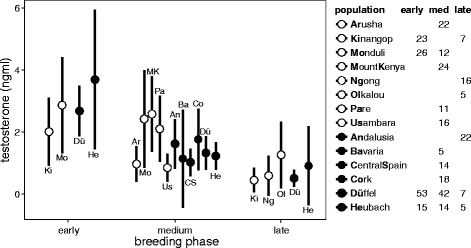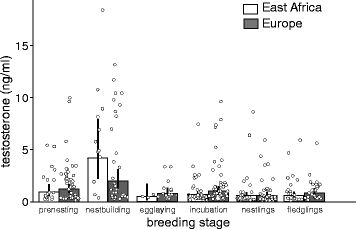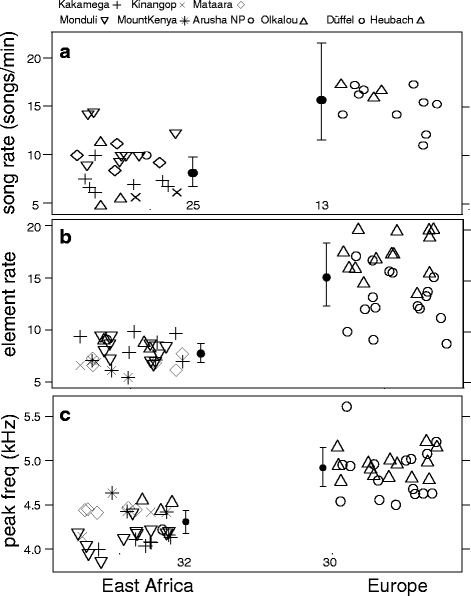Testosterone, territorial response, and song in seasonally breeding tropical and temperate stonechats
- PMID: 28412929
- PMCID: PMC5392926
- DOI: 10.1186/s12862-017-0944-9
Testosterone, territorial response, and song in seasonally breeding tropical and temperate stonechats
Abstract
Background: Testosterone facilitates physiological, morphological, and behavioral changes required for breeding in male vertebrates. However, testosterone concentrations and the link between its seasonal changes and those in reproductive behaviors vary greatly among species. To better understand the impact of tropical and temperate environments and life history factors on this variation, we have compared testosterone, territorial behavior and song performance across sequential stages of the breeding season in males of 16 closely related taxa of East African tropical and West European temperate stonechats (Saxicola spp), which all breed during a short breeding season, but differ in migratory behavior, seasonal territory-acquisition and pace of life.
Results: We found that generally, the profiles of testosterone and territorial behavior were similar across latitudes. African stonechats with a slow pace of life had equally high peak testosterone concentrations and responded as aggressively to an intruder as European stonechats with a fast pace of life. However, song performance at the beginning of the breeding season was lower in African than in European stonechats. The differences in song performance were not associated with variation in testosterone levels between tropical and temperate stonechats.
Conclusions: The results suggest a very similar role for testosterone as a mediator of high intensity territorial aggression during the fertile period of females in tropical and temperate stonechats, which all are highly seasonal, locally synchronous breeders. A potential explanation may be high risk of extra-pair copulations which has been associated with synchronous breeding. Interestingly, an association was not consistent for song performance. Our data suggest that song performance can be disassociated from peak testosterone levels depending on its role in breeding behavior. Despite similar testosterone levels, European males, which early in the breeding season acquire territories and mates, showed greater song performance than African stonechats, which maintain year-round territories and pair-bonds. Taken together, our study comparing related taxa of old world songbirds suggests that short breeding seasons may be a major selective force for high peak testosterone levels during breeding regardless of latitude and pace of life, but that particular behaviors, in our case song, can be uncoupled from peak testosterone levels.
Keywords: Breeding season length; Migratory behavior; Song; Songbirds; Steroid hormones; Temperate; Territorial behavior; Testosterone; Tropical.
Figures




Similar articles
-
Baseline and stress-induced levels of corticosterone in male and female Afrotropical and European temperate stonechats during breeding.BMC Evol Biol. 2017 May 22;17(1):114. doi: 10.1186/s12862-017-0960-9. BMC Evol Biol. 2017. PMID: 28532466 Free PMC article.
-
Territorial aggression does not feed back on testosterone in a multiple-brooded songbird species with breeding and non-breeding season territoriality, the European stonechat.Horm Behav. 2017 Jan;87:89-95. doi: 10.1016/j.yhbeh.2016.11.002. Epub 2016 Nov 10. Horm Behav. 2017. PMID: 27838361
-
Seasonal differences in the hormonal control of territorial aggression in free-living European stonechats.Horm Behav. 2002 Feb;41(1):1-8. doi: 10.1006/hbeh.2001.1720. Horm Behav. 2002. PMID: 11863378
-
Seasonal plasticity in the song control system: multiple brain sites of steroid hormone action and the importance of variation in song behavior.Ann N Y Acad Sci. 2004 Jun;1016:586-610. doi: 10.1196/annals.1298.043. Ann N Y Acad Sci. 2004. PMID: 15313796 Review.
-
Ecological constraints and the evolution of hormone-behavior interrelationships.Ann N Y Acad Sci. 1997 Jan 15;807:22-41. doi: 10.1111/j.1749-6632.1997.tb51911.x. Ann N Y Acad Sci. 1997. PMID: 9071342 Review.
Cited by
-
Hypothalamic-Pituitary-Thyroid Axis Crosstalk With the Hypothalamic-Pituitary-Gonadal Axis and Metabolic Regulation in the Eurasian Tree Sparrow During Mating and Non-mating Periods.Front Endocrinol (Lausanne). 2020 May 29;11:303. doi: 10.3389/fendo.2020.00303. eCollection 2020. Front Endocrinol (Lausanne). 2020. PMID: 32547486 Free PMC article.
-
Divergent patterns of telomere shortening in tropical compared to temperate stonechats.Ecol Evol. 2018 Dec 26;9(1):511-521. doi: 10.1002/ece3.4769. eCollection 2019 Jan. Ecol Evol. 2018. PMID: 30680132 Free PMC article.
-
Baseline and stress-induced levels of corticosterone in male and female Afrotropical and European temperate stonechats during breeding.BMC Evol Biol. 2017 May 22;17(1):114. doi: 10.1186/s12862-017-0960-9. BMC Evol Biol. 2017. PMID: 28532466 Free PMC article.
-
Across time and space: Hormonal variation across temporal and spatial scales in relation to nesting success.Gen Comp Endocrinol. 2020 Jun 1;292:113462. doi: 10.1016/j.ygcen.2020.113462. Epub 2020 Mar 28. Gen Comp Endocrinol. 2020. PMID: 32171744 Free PMC article.
-
Seasonal Expression of Gonadotropin Genes in the Pituitary and Testes of Male Plateau Zokor (Eospalax baileyi).Animals (Basel). 2022 Mar 14;12(6):725. doi: 10.3390/ani12060725. Animals (Basel). 2022. PMID: 35327122 Free PMC article.
References
-
- Nelson RJ. An Introduction to Behavioral Endocrinology. Third Edition. Sunderland: Sinauer Associates, Inc. Publishers; 2005.
-
- Adkins-Regan E. Hormones and animal social behavior. Hormones and animal social behavior. Princeton University Press: Princeton; 2005.
-
- Silverin B. Effects of long-acting testosterone treatment on freeliving pied flycatchers, Ficedula hypoleuca, during the breeding period. Anim Behav. 1980;28:906–912. doi: 10.1016/S0003-3472(80)80152-7. - DOI
-
- Ketterson ED, Nolan JV, Wolf L, Ziegenfus C. Testosterone and avian life histories: effects of experimentally elevated testosterone on behavior and correlates of fitness in the dark-eyed junco (Junco hyemalis) Am Nat. 1992;140:980–999. doi: 10.1086/285451. - DOI
-
- De Ridder E, Pinxten R, Eens M. Experimental evidence of a testosterone-induced shift from paternal to mating behaviour in a facultatively polygynous songbird. Behav Ecol Sociobiol. 2000;49:24–30. doi: 10.1007/s002650000266. - DOI
Publication types
MeSH terms
Substances
LinkOut - more resources
Full Text Sources
Other Literature Sources
Miscellaneous

